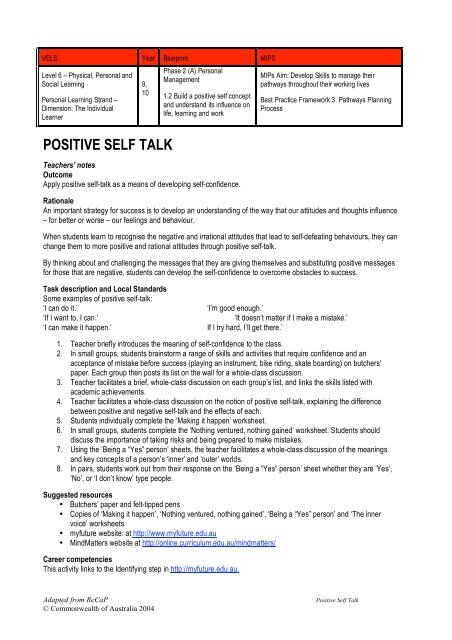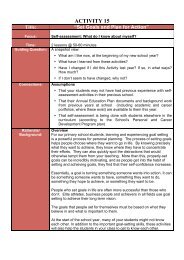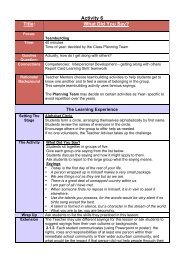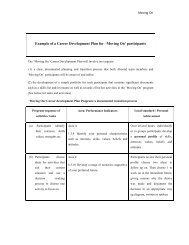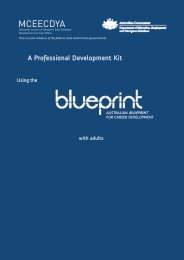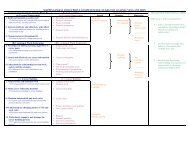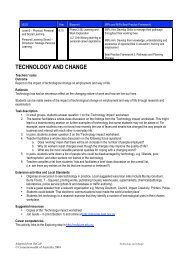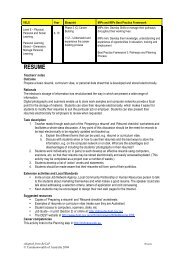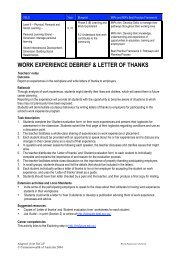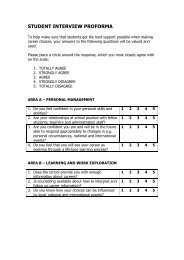4. Positive Self Talk - Blueprint - Australian Blueprint for Career ...
4. Positive Self Talk - Blueprint - Australian Blueprint for Career ...
4. Positive Self Talk - Blueprint - Australian Blueprint for Career ...
- No tags were found...
Create successful ePaper yourself
Turn your PDF publications into a flip-book with our unique Google optimized e-Paper software.
VELS Year <strong>Blueprint</strong> MIPSLevel 6 – Physical, Personal andSocial LearningPersonal Learning Strand –Dimension: The IndividualLearner9,10POSITIVE SELF TALKPhase 2 (A) PersonalManagement1.2 Build a positive self conceptand understand its influence onlife, learning and workTeachers’ notesOutcomeApply positive self-talk as a means of developing self-confidence.MIPs Aim: Develop Skills to manage theirpathways throughout their working livesBest Practice Framework 3. Pathways PlanningProcessRationaleAn important strategy <strong>for</strong> success is to develop an understanding of the way that our attitudes and thoughts influence– <strong>for</strong> better or worse – our feelings and behaviour.When students learn to recognise the negative and irrational attitudes that lead to self-defeating behaviours, they canchange them to more positive and rational attitudes through positive self-talk.By thinking about and challenging the messages that they are giving themselves and substituting positive messages<strong>for</strong> those that are negative, students can develop the self-confidence to overcome obstacles to success.Task description and Local StandardsSome examples of positive self-talk:‘I can do it.’ ‘I’m good enough.’‘If I want to, I can.’‘It doesn’t matter if I make a mistake.’‘I can make it happen.’ If I try hard, I’ll get there.’1. Teacher briefly introduces the meaning of self-confidence to the class.2. In small groups, students brainstorm a range of skills and activities that require confidence and anacceptance of mistake be<strong>for</strong>e success (playing an instrument, bike riding, skate boarding) on butchers’paper. Each group then posts its list on the wall <strong>for</strong> a whole-class discussion.3. Teacher facilitates a brief, whole-class discussion on each group’s list, and links the skills listed withacademic achievements.<strong>4.</strong> Teacher facilitates a whole-class discussion on the notion of positive self-talk, explaining the differencebetween positive and negative self-talk and the effects of each.5. Students individually complete the ‘Making it happen’ worksheet.6. In small groups, students complete the ‘Nothing ventured, nothing gained’ worksheet. Students shoulddiscuss the importance of taking risks and being prepared to make mistakes.7. Using the ‘Being a “Yes” person’ sheets, the teacher facilitates a whole-class discussion of the meaningsand key concepts of a person’s ‘inner’ and ‘outer’ worlds.8. In pairs, students work out from their response on the ‘Being a “Yes” person’ sheet whether they are ‘Yes’,‘No’, or ‘I don’t know’ type people.Suggested resources• Butchers’ paper and felt-tipped pens• Copies of ‘Making it happen’, ‘Nothing ventured, nothing gained’, ‘Being a “Yes” person’ and ‘The innervoice’ worksheets• myfuture website: at http://www.myfuture.edu.au• MindMatters website at http://online.curriculum.edu.au/mindmatters/<strong>Career</strong> competenciesThis activity links to the Identifying step in http://myfuture.edu.au.Adapted from ReCaP© Commonwealth of Australia 2004<strong>Positive</strong> <strong>Self</strong> <strong>Talk</strong>
<strong>Positive</strong> <strong>Self</strong>-<strong>Talk</strong> Worksheet: Making It HappenA little voice in our head gives us messages. Sometimes the messages say that we are clever and doing well. Atother times they say that we are ‘stupid’ or that we can’t do anything.Write down how you feel when the messages are negative as well as how you feel when they are positive. The firsthas been done as an example.You can also add some other situations to the list.Situation Negative self-talk <strong>Positive</strong> self-talkExample:Speaking to someone newI’m dull. They won’t want to talk tome.I’m interesting. Maybe I’ll make anew friend.Feelings Frightened Excited1. Trying a new problem I’ll make a mistake. The more I try the better I’ll get.Feelings2. Giving a talk to the class They’ll laugh and tease me. I can do it.Feelings3. Asking if you can join a game They don’t like me. This will be fun.Feelings<strong>4.</strong> Asking to borrow something They’ll say no.They’ll say yes.specialFeelings5. Giving an opinion They’ll all laugh. They’ll think I’m smart.Feelings6. Making a speech I’ll make a fool of myself. I’ll do a pretty good job.FeelingsOther situationsSituation Negative self-talk <strong>Positive</strong> self-talk7.Feelings8.Feelings9.Feelings10.Feelings11.FeelingsAdapted from ReCaP© Commonwealth of Australia 2004<strong>Positive</strong> <strong>Self</strong> <strong>Talk</strong>
<strong>Positive</strong> <strong>Self</strong>-<strong>Talk</strong> Worksheet: Nothing Ventured, Nothing GainedSome people don’t try new things because they’re scared.1. What would be the worst thing that could happen if you didn’t do as well as you would like at:Learning pottery? _________________________________________________________________________Reading aloud? __________________________________________________________________________Surfing? ________________________________________________________________________________Trying a new hairstyle? ___________________________________________________________________Introducing yourself to someone new? _________________________________________________________Learning the piano? _______________________________________________________________________2. List some additional activities you could try and give the worst and best things that could happen.I should try The worst that could happen The best that could happen3. The messages we give ourselves are called ‘self-talk’. Give four examples of negative self-talk that could makeyou feel frightened of trying something new.a._________________________________________________________________________b. ________________________________________________________________________________c. ________________________________________________________________________________d. ________________________________________________________________________________<strong>4.</strong> Now give the positive self-talk that should replace these negative messages.a._________________________________________________________________________b. ________________________________________________________________________________c. ________________________________________________________________________________Adapted from ReCaP© Commonwealth of Australia 2004<strong>Positive</strong> <strong>Self</strong> <strong>Talk</strong>
d. ________________________________________________________________________________Adapted from ReCaP© Commonwealth of Australia 2004<strong>Positive</strong> <strong>Self</strong> <strong>Talk</strong>
<strong>Positive</strong> <strong>Self</strong>-<strong>Talk</strong> Worksheet : The Inner Voice• Being a positive learner is about the language you use when you talk to yourself.• We have three internal voices – the YES voice, the NO voice, and the I DON’T KNOW voice.• As a human being, you have an inner world and an outer world.• Your inner world is made up from your thoughts and your feelings (plus a lot of physical things, like your spinalcord, heart, intestines, lungs, etc).• Your outer world is made up of the other things – other people, buildings, circumstances, family, the weather,your outer environment.• Within your inner world there is a voice – this is your Inner Voice of thought.• Our Inner Voices talk to us in certain ways. Sometimes they talk to us in a YES voice, sometimes in a NOvoice and sometimes in an I DON’T KNOW voice.• The great news <strong>for</strong> learning and living is that we can program our Inner Voice and become the voice and theperson we wish to be. What we say with our Inner Voice will show up as ‘living’ to the Outer World people.• This is great news, because it means our Inner Voice is powerful.• It means you are powerful.• The more you choose to program a YES voice, the more powerful you will be!Adapted from ReCaP© Commonwealth of Australia 2004<strong>Positive</strong> <strong>Self</strong> <strong>Talk</strong>
What makes a ‘Yes’ person?<strong>Positive</strong> <strong>Self</strong>-<strong>Talk</strong> Worksheet 4: Being A ‘Yes’ PersonYes No I don’t knowI’ve got this task to do: YESNo, I can’t do it!I don’t know.I’ll give it my best shot!I will be able to do this. This is silly, this is stupid. I’m not sureThere is a solution and I’ll find it. I can’t do this: it‘s too hard. I think I’ll try!I’ll do it now! I’ll do it tomorrow (next week). I could do it tomorrow.Sounds good, I’ll give it a go.I’m hopeless. This is impossible: I’mnot even going to try!I don’t know about that. Maybe I’ll waitand see.I can do it, it may take time and ef<strong>for</strong>t I’m dumb.I could but I’ve got a cold.but I can do it!Yes, I made that mistake and I can It’s not my fault, don’t blame me (it is Don’t ask me!learn from the experience.their fault ... teachers, parents, boss).That person has some really goodpoints.I don’t like that person.I’m not sure. I’ll wait to see how theymatch up.I’m good at ... (maths, reading). I’m hopeless at ... I’m not really good at anything.I am a learner. They’ll laugh at me. I’m tired.I am good value. I’m no good. I am not sure of myself.So, what makes a YES person?• YES people have a YES physiology. A YES body language is confident and happy.• A YES face is open and smiles a lot.• YES people look <strong>for</strong> possibilities and not restrictions.• YES people see problems as learning and seek solutions rather than being stuck in the problem.• YES people celebrate themselves and others.• YES people program their Inner Voices <strong>for</strong> YES living.• YES people communicate clearly and openly.• YES people stretch their thinking and train their brains.Adapted from ReCaP© Commonwealth of Australia 2004<strong>Positive</strong> <strong>Self</strong> <strong>Talk</strong>


